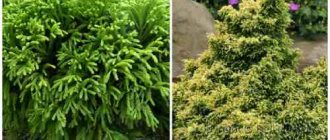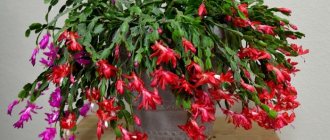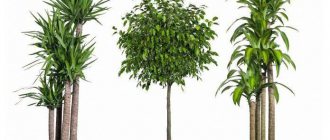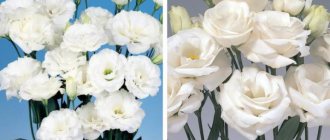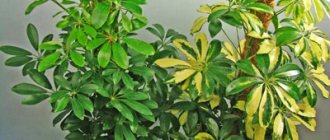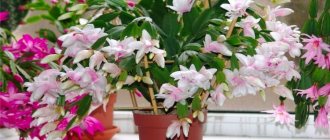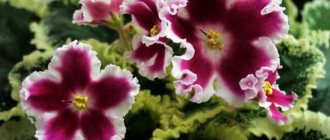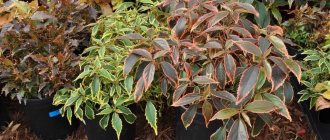Lavender is an evergreen perennial shrub. It attracts people's attention, as its elegance, richness of color and aroma cannot leave anyone indifferent.
Author of the article
Eduard Dmitriev
Florist and lover of indoor and garden plants.
Since ancient times, this plant has been used as a medicine.
Due to its unusual aroma, it is used in the production of perfumes. The French province of Provence is the leader in the cultivation of this plant: 80% of lavender is grown in picturesque French places.
Having managed to adapt lavender to overcome cold climates, this representative of the plant world has become the most recognizable decoration of gardens.
Description of lavender
The medicinal shrub belongs to the Lamiaceae family. The natural habitat is the territories of southern Europe, the Mediterranean, northeast Africa, India, Arabian lands and the mountainous regions of the Caucasus.
The plant has a taproot, woody and developed root system. The stems are straight, the leaves are narrowed, with smooth or jagged edges. Peduncles rise above the main part of the plant. Collected from six to ten flowers. The inflorescence is a spike. The flowers themselves are painted white or purple. The color of the flower varies depending on the species, of which there are quite a lot. When the lavender flowering comes to an end, you can observe the formation of dry seeds.
Lavender blossoms
To achieve bright and rich flowering of lavender, certain conditions must be observed. The flowering itself begins from the first days of summer until autumn. Since there are many varieties, you can enjoy the flowering of this plant in gardens from spring to autumn. Plants that are planted in groups produce a very great effect. During the flowering period, they resemble a very large, beautiful and fluffy carpet.
Types and varieties
So far, only such types of lavender are grown in cultivation as lavender angustifolia (English) and French lavender, also known as broadleaf. But since there are other types of lavender suitable for cultivation, we offer you a description of them. So:
French lavender (Lavandula stoechas)
Or broadleaf lavender (Lavandula latifolia) native to South-West Europe. It is distinguished by its strong aroma and beauty of flowers in different shades of purple, pink, lilac, green, burgundy and white. Flowering in French lavender begins earlier than in other plant species - in April or May - and continues until July, but at the end of summer, broadleaf lavender can bloom again. French lavender is not as cold-hardy as English lavender, so it is grown mainly in warm areas.
The most popular variety of this species is Lavandula stoechas pedunculata, or "butterfly" (Papillon), with flowers of an original shape. The most famous varieties of broadleaf lavender are:
- Yellow Vale is a variety with dark purple flowers, crimson bracts and yellow-green leaves;
- Regal Splendur - a variety with dark purple flowers;
- Rocky Road is a new variety with large lilac-blue flowers that bloom in July;
- Tiara - large blue flowers with cream bracts;
- Helmsdale is a variety with lilac-burgundy flowers.
In the photo: French lavender (Lavandula stoechas)
Hybrid lavender (Lavandula x intermedia)
Or Dutch lavender is a group of highly decorative hybrids between English lavender and other species of the genus. These are large plants with silvery narrow leaves and large oblong flowers on long peduncles that bend under the weight of the flowers. Hybrid lavender begins to bloom in July.
- Carnation Shabo: growing from seeds, planting and care
The most famous varieties of Dutch lavender:
- Alba is a variety with white flowers;
- Arabian Knight - a variety with flowers of dark blue or dark purple color;
- Sawyers - form with light purple flowers;
- Grosso - a variety with large flowers of a lilac-violet hue;
- Richard Gray is a compact bush with dark purple flowers.
In the photo: Hybrid lavender (Lavandula x intermedia)
Toothed lavender (Lavandula dentata)
Comes from the Mediterranean. This is a heat-loving compact plant with soft, rugged leaves of a silvery hue and large, fragrant flowers that open in July. The plant is not cold-resistant. The most popular variety of scalloped lavender is Royal Crown, a plant with purple flowers.
In the photo: Toothed lavender (Lavandula dentata)
Lavender angustifolia (Lavandula angustifolia)
Either English lavender (Lavandula spicata) or lavender officinalis (Lavandula officinalis) comes from Southern Europe. It is a perennial shrub with silver-green leaves and small bluish-lilac flowers that bloom in July or August. This is the most winter-hardy type of lavender. The most famous variety of angustifolia lavender is delphinium lavender, which reaches a height of no more than 30 cm, but has very beautiful silvery foliage. Hidcoat lavender is also widespread and is used mainly for low hedges.
Among the varieties of English lavender, the most popular in culture are:
- Alba - a variety up to 50 cm high with white inflorescences;
- Rosea is a bush up to 40 cm high with lilac-pink flowers;
- Manstead is a bush about 40 cm high with deep blue flowers;
- Hidcoat Giant is a compact plant up to 60 cm high;
- Hidcoat Blue is a compact bush up to 40 cm high with blue-violet inflorescences.
In the photo: Narrow-leaved lavender (Lavandula angustifolia)
Properties of lavender
Lavender is rich in tannins, aromatic lactones, alcohols and acids. In addition to what is listed, it contains a lot of useful and interesting things. Many of its components, and especially the resulting essential oil, are used in the treatment of many diseases.
Uses of lavender
In folk medicine, dried and fresh lavender is used for problems with the central nervous system and stressful situations, with the gastrointestinal tract, with poor digestion and ailments of the female reproductive system and respiratory organs. To treat such diseases, decoctions and infusions based on lavender are prescribed.
Lotions and essential oils are prescribed for insect bites and skin problems. Such lavender-based products improve the condition of hair. In addition, it is used in massage medicine. Aromatherapy is also an area in which lavender is indispensable.
- Lavender-based tea is an excellent remedy for insomnia and nervous exhaustion. Relieves attacks of nausea and pain during menstruation. The recipe for making tea is simple: throw 2 or 3 tablespoons of dried flowers into a glass of boiling water.
- Leave for about 15 minutes. But you shouldn’t abuse it: 2-3 cups a day and no more! Otherwise, stomach upsets and allergic manifestations may occur.
This plant is also used in cooking! In addition to tea, it is added to various dishes to give a unique taste and aroma.
Lavender essential oil
Due to its unique medicinal properties, essential oil is in great demand in various industries. It is obtained mainly from flowers. The oil content in them reaches 0.8%. The color is almost colorless, but with a subtle yellowish tint. Included in many cosmetic products. Used to strengthen hair and nourish the head, removes dandruff.
The essential oil is not an allergen, but its heavy aroma may not be suitable for some people. If discomfort or difficulty breathing occurs, use should be discontinued. It is not recommended to use the oil for pregnant women, breastfeeding women, or hypertensive patients. The main reason for this ban is the oil’s ability to change hormonal levels and blood pressure.
History of the perennial bush plant and its name
Lavender came from the Mediterranean, Canary Islands, Cape Verde, southeast India, southwest, Asia Minor .
North and East Africa, Arabia, southwestern Europe, and the Mediterranean can also be considered the cradle of this culture, since it first spread across the listed territories.
Somewhat later, the flower came to Great Britain (1600) and the rest of Europe . Australia received the subshrub from travelers only in 1922, but the plant from this continent is considered the most expensive.
The flower was known to the ancient civilizations of Asia, Africa, and India; it is mentioned by Egyptian, Roman, and ancient sources. Lavender is described by Hippocrates, Avicenna, Galen, it was used by the Egyptians for embalming.
It was the Romans who contributed to the spread of lavandula throughout Europe and gave it its name (Latin lava - to wash), but there are also versions that the term comes from Lat. Livere – bluish .
European intensive cultivation of lavandra began in the Middle Ages. The plant was used in the manufacture of soap and eau de toilette. The flower and recipes with it were described by the German nun Hildegard (1179) - this is considered to be its first phytotherapeutic European mention. The crop began to be grown industrially on monastery plots.
The first perfume - Hungarian Queen Water - was created in Europe (14th century) based on lavender, then Lavender (Cologne) water, also known as cologne, appeared. The flower was used by the Armenian physician Amirdovlat Amasitsiani (15th century), and it is mentioned by the herbalist John Parkinson (17th century).
Let's list the name options:
- lavandula is the official Latin international name. There is also lat. the term lavenda, but it is rarely used.
- lavanda (Italian), lavandra (old French), lavande, lavendula, lavender.
- Lavender, lodelavan, lodilavand, dodelavand (l'eau de lavande), levender, lavandarium.
- Nard, nardus (Syria, ancient world, from the name of the city).
- Ostohododus, ustuhudus (the name was used by Avicenna).
- Alhucema (algucema), alucema. Spanish-speaking countries, southern North America.
- Lavandin. These are hybrids with increased amounts of nutrients and improved characteristics.
Lavandra especially spread in France, its promotion (perfumery, medicine, cosmetology) was contributed by perfumer Rene Gattefosse, Dr. Jean Valnet (20th century).
The first professional breeding work on lavender was carried out by European, English, and American scientists (19th century). But domestic breeders took up ustuhudus only from the middle of the 20th century , which, however, does not reduce the high quality of the varieties bred.
Is it annual or not?
Without exception, all varieties of lavender are only perennial.
Maximum lifespan is 25 years. But this average figure is 8-12 years, even if the variety lives longer, then such bushes are considered old, excessively lignified, despite annual pruning, and it is advisable to replace them.
Let us clarify the issue of annual varieties. Ustuhudus never happens like this. But this term is sometimes added to the description of certain varieties : it only means that a certain variety has the advantages of annual plants, being perennial in nature.
This is the Normandy or French lavender, as well as Multifida, also known as multi-cut or Egyptian. It would be more accurate to call them “varieties with rapid growth, flowering in the first year of life.” This variety will produce flowers already in the second month after planting.
Important ! “Annual” lavender varieties are not actually such. They are called that because of their rapid growth, good germination, and flowering in the first year.
They are often planted if you plan to keep the shrub for only one year, for example, before it freezes out or is replaced. The gardener will have time to enjoy the flowers and aroma. At the same time, there are no warnings regarding the use of these varieties as perennials.
Advantages of Alhucema varieties more suitable for planting for 1 year:
- grows faster, blooms in the first year;
- many varieties of Lavandula do not tolerate planting in containers, but the conventionally annual varieties we describe are ideal for planting in containers and pots;
- give good, persistent self-seeding;
- if the plant is kept for one year, then the agricultural technology is simpler, without pruning (for splendor, you just need to pinch off the top of the seedling after 3-4 pairs of leaves appear);
- the aroma is thicker, sharper, with more pronounced coniferous, spicy notes.
Wild or garden
Garden lavande are varieties that are more suitable for landscape design , planting on plots; they have the best aesthetic qualities.
That is, almost all seed purchased from nurseries is of this type - few people sell wild lavandula for cultivation.
But a cultivated subshrub without care can go wild (whether it will survive is another question), which means a loss of properties of the variety (splitting, degeneration), a decrease in nutrients, and a deterioration in aesthetics. This often happens with plants grown from self-seeding.
Wild Lavandula is almost never found in nature in Russia, except in warm, southern regions, including those with mountainous terrain (they are more protected from winds and cold). At the same time, you can often observe how on the site or beyond its borders this subshrub grows from self-seeding and lives without special care.
Wild Ustuhudus sometimes looks quite presentable , especially if it is young and has not yet become woody, but usually these are more inconspicuous, unsightly bushes. The plant quickly becomes tree-like, the flowers on it are solitary, the volume of greenery is small, the bush is disheveled, sometimes spreading along the ground due to excessive forcing. But this does not reduce viability, except that in frosts the branches are more susceptible to damage.
Peculiarity ! Garden lavender must be pruned annually, starting from the second year of life, allowing it only minimal growth, which slows down lignification and ensures the lushness of the bush.
Botanical characteristics
Botanical information about lavandula, which family it belongs to:
- Genus from the family Lamiaceae or Labiatae.
- Essential oil crop.
- Cross-pollinated.
- Subshrub (chemephyte), that is, a plant that has both herbaceous (top) and tree-like (bottom) segments. The first ones capable of growing back when pruned or dying.
- Evergreen.
- Perennial.
The following parameters are typical for most species, except for the shape of leaves and inflorescences.
We described the latter of angustifolia lavender (spike, true), but in numerous species of lavender and its hybrids there are a lot of characteristics of these particular parts, which must be especially taken into account when studying.
Characteristics of Lavandula angustifólia:
- A strong, extremely persistent odor in flowers, leaves, and to a lesser extent in herbaceous stems, but only with high-quality seed.
- The root system is outstanding - branched, deep, very strong. The root is woody, fibrous, taprooted, branched, reaching a depth of up to 2 m, with numerous long roots extending in all directions.
- There are always lignified segments below. Such parts are branched, rising with numerous straight herbaceous shoots.
- Flowering branches are tetrahedral, have long internodes (up to 30-45 cm).
- The leaves are opposite, sessile, narrow (up to 6 mm wide), oblong, linear, 2-8 cm long, green, with entire rolled edges. Pubescence may be present, which gives a bluish, gray tint. Let us remember that many other species have leaves of a different shape, with other parameters (but in general they are all small): with teeth, wide, branched.
Interesting ! The stem of lavender resembles a wildflower: the same long, thin with small leaves, with the same sometimes inconspicuous flowers. But many buds in a well-groomed bush make it lush, create the impression of luxury, and form a solid semicircular shape with a uniform color.
Seeds (nuts), as a rule, are more uniform . And the situation with flowers is the same as with leaves - their shape and shade can vary significantly. There are blue, light blue, turquoise, lilac, reddish, white (Elegance Snow) varieties. We will describe the same Lavandula angustifólia:
- Flowering begins in June and lasts about 1 month.
- Repeated flowering is possible in late summer and early autumn in warm regions.
- The flowers are small in size, 6-10 in rare false half-whorls. From above they transform into long interrupted spike-shaped racemes 2-8 cm long. The corolla is two-lipped, about 10 mm long, usually pubescent.
- The color of the flowers is usually violet-pink, bluish-violet.
- The fruit (seeds) are four hard, glossy, brown nuts 1-2 mm long inside a lagging calyx.
What it looks like, description and photo of the bush
You can distinguish lavender from other perennial subshrubs by smell, shape of leaves, and inflorescences. You can easily recognize an adult bush by its branches : they are thin, elastic, stick out like arrows, the leaves on them are sparse and small.
That is, lavender is more refined, not so thick with greens, somewhat thinned out.
For example, sage and hyssop have larger inflorescences (candles), and the leaves are wide, in the shape of a classic spearhead, the branches are thick, more herbaceous.
Appearance of the bush and flowers:
- Bush:
- Height 30-80 cm, maximum up to 100 cm. Rarely can be found up to 150 cm.
- Strongly branched below, spreading (width 1.5 m).
- The crown is spherical in well-groomed plants.
- The trimmings are given into a spherical, semicircular shape, then a uniform, thick “hedgehog” of inflorescences is formed. If the bush is wild, then in terms of beauty it may have the exact opposite impression. An unkempt plant is loose, disheveled, spreading along the ground, with a small amount of greenery and flowers, with noticeable tree-like bare branches below.
- The inflorescences are spike-shaped (long or cone-shaped) and frequent. A well-groomed bush with them resembles a ball (oval) with a uniform color.
Peculiarity ! Lavender grows only from below, so the bush looks like a set of elastic, straight, arrow-like shoots ending in spicate (spike-shaped) inflorescences (long or short, cone-shaped). Along the entire length are herbaceous segments of branches, and sometimes their semi-lignified parts, evenly, but at large intervals, strewn with small leaves.
The Alucema bush does not always look like in the photographs of specially selected specimens (a solid, dense and lush ball), but even in a more disheveled form it is quite beautiful.
Inflorescences can be of different shapes:
- often in the form of long or small cone-shaped spikelets (a small plump section that ends a branch);
- slightly reminiscent of a spikelet: the buds are located near each other, but at certain intervals, forming such a long segment (5, and sometimes up to 15 cm).
This is what the lavender bush looks like in the photo:
The aroma of lavandula and its features
Features of the smell of alhucema:
- persistent, lasts for years;
- with noticeable chemical (chemical, unnatural) notes;
- there is an extremely successful balance - this is one of the smells used for epilepsy;
- the aroma combines citrus, woody, coniferous shades.
Peculiarity ! With skillful use, the shortcomings of the aroma (excessive harshness, chemicality) of lavender disappear. For example, in perfumery it is shaded with the smells of coffee, oud, saffron, and incense. The sound of lavandula in the right proportions of ingredients is cold and pungent. This is the essence of freshness, the smell of the Alps, snow-capped mountains, springs, purity. In aromatherapy, a popular combination is with hop cones and lemon balm.
You will find a detailed description of the smell of lavender and its effect on the human body in this article.
Lavender care and planting
Without human intervention, the lavender bush grows and develops on its own. However, in this case, it is better not to think about the attractive appearance and beautiful flowering at all. He definitely won't be there. Experienced gardeners and flower growers recommend caring for the plant to ensure the attractiveness of the lavender bush, to achieve its spherical shape and lush flowering.
- The first thing to do is to fluff up the soil under the stem for better oxygen supply and pull out the weeds. Such simple manipulations will allow you to achieve a presentable appearance and long flowering.
- The condition of the soil will help determine when to water. If it is dry, then you definitely need to increase the watering of the lavender. It's important not to overdo it here.
Planting should be done in places where there is enough light and warmth. Lavender, however, can grow in the shade, but if there is insufficient lighting, its decorative effect will suffer.
To improve the condition of the soil, compost or nutrient mixtures are added to it. It is best to place them under the stem, but so that the soil above the roots is not laid, otherwise this may cause them to rot.
Before wintering, the bush is pruned. There should be 10-15 centimeters left at the base. Gardeners advise growing lavender in large pots, which makes it easier to bring it indoors in late autumn and makes care much easier. Also, timely pruning will help improve growth and provide the desired decorative appearance.
Top dressing
To feed lavender, combined mineral fertilizers or nitrogen-based fertilizers are used. Fertilizer is best used before flowering. Under no circumstances should you re-fertilize in the summer, because with such improved plant growth, it will not be able to properly prepare for autumn and cold weather.
Trimming
To achieve an attractive appearance, pruning is required. If you let the development of lavender take its course, you can end up with a monster with a tall stem, bare at the base, and sparse faded leaves.
When young plants (about 20 centimeters) are planted in April, it is advised to trim the randomly spread shoots to improve subsequent growth. After this, until next spring, you need to leave the lavender alone. When April comes again, you need to remove last year's dried inflorescences.
It is very important not to cut off too much when pruning. Many people remove flower stalks in the fall. True, spring is better for this. Preserved inflorescences, even if dry, will help lavender survive the cold period.
As soon as the flowering period has passed, do not prune the bush! It will have shoots. They are still very weak and may not survive the approaching cold.
Combination with other plants in the garden
When purchasing plants, gardeners think about how to plant lavender on the site so that it looks most advantageous with other flowers.
- The field plant looks good when planted in stripes along paths and on an alpine hill. In a mixborder it is wonderful with roses, especially with pink petals.
- To decorate a slope, southern shrubs can be planted together with trees: lilacs, junipers or rhododendrons.
- A spicy flowerbed in the yard will be original, where lavender bushes will coexist with catnip, mint, thyme, yarrow, and sage.
You have learned how to grow lavender, and now you can confidently begin to realize your dream - to have such a fragrant and healthy plant in your summer cottage.
Pests and diseases
Lavender is a very strong plant. However, it still has pests and diseases.
The most common disease of lavender is gray mold. Gray-brown spots appear on the stem of a diseased plant and rise higher. The leaves fade and wither. Flowers and fruits are also subject to detrimental effects.
If the infection is severe, the lavender may die. The main cause of rot is mainly poor maintenance. Excessive watering negatively affects the life of lavender. Water stagnates, thereby causing rot. In this case, you need to reduce watering.
If the plant is already sick, then you need to cut off the infected parts and burn them away from everyone else. After this, you can treat the lavender with a 1% Bordeaux mixture. As a last resort, you can use a fungicide.
There are two main pests: the pennies and the rainbow beetles. The pennitsa is a hemipteran insect from the cicada family. It eats leaves by gnawing holes. The pennix leaves its offspring on the trunks, attaching them with easily washed off water.
The stag beetle also likes to profit from the leaves of the bush. Damages the teeth on the edges of the leaves. Both insects are removed by hand because chemicals can harm the plant.
Methods of application
How and in what form is lavender used:
- Essential oil and lavender alcohol for rubbing and aromatization.
- “Sleepy pillows” (dried stems and flowers with hop cones, lemon balm).
- Infusion (0.5 liters of boiling water - 2 tbsp.) and tea. For insomnia, headaches, stress, high cholesterol, gastrointestinal ailments and digestive disorders, especially those accompanied by fermentation.
- Herbal infusions (for example, there is composition No. 1 for hypertension due to menopause).
- Baths with the addition of decoction or essential oil.
- Skin masks, lotions, creams.
- Dried grass in bags is placed in cabinets to get rid of moths. Lavender is planted near roses to discourage aphids and ants.
Particular attention should be paid to the use of lavender for women's problems (painful menstruation, infertility), which was pointed out by herbalists and healers in ancient times, but we must take into account the contraindications we described.
The medicinal properties of ustuhudus against diseases are recognized only in herbalism , in the folk and traditional industries (for example, in Germany at the official level). The rest of medicine (classical) does not have officially confirmed effects of lavender against diseases, but this situation arose only due to the lack of high-quality research, although dozens of tests and observations were carried out.
The use of lavender is described in this video:
Find more information on how to use lavender here.
Planting and propagating lavender
There are several options for propagating lavender bushes. Seeds must be kept in a humid environment with low air temperatures for three weeks. In general, growing lavender by seed is a very complex and time-consuming process, so it is rarely used.
When purchasing, you should look for young lavender bushes that are adapted to the given environmental conditions. Gardening experts suggest planting lavender in the spring, as soon as the night frosts stop.
Planting can also be done in the fall. But the autumn period is suitable only for the southern regions and with the condition that there are at least two months left before the cold weather. Before planting, the lavender bush should be immersed in cold water for an hour and a half.
Lavender likes to grow on hills, so beds for it should be arranged there. If these are not observed, then you need to make the beds high - around forty centimeters.
To improve further growth, the top of the lavender bush is trimmed. Roots and stems that branch during growth must be removed. Seedlings are planted in depressions from 20 to 30 centimeters.
The gap between two lavender specimens is equal to the height of an adult bush. Lavender seeds have the ability to germinate for a long time. But this is only possible if they are stored correctly. Once the seeds are collected, they are placed in a secure, dry container. When autumn comes, they can be planted in open ground without additional preparation.
In landscape design and interior
Lavender is versatile in landscape design and goes well with most plants and with any features of the topography, shape of the site, or garden. The subshrub feels great with roses, succulents, and herbs. Barberry, croton, phlox, daffodils, and mock orange are planted with it. Additionally, lavender protects neighbors from aphids and ants.
Lavandula can be used for any solution with high efficiency. Advantages in garden design :
- great both for the background (for example, roses above and a subshrub below) and as a main plant;
- as a border plant and for filling gaps in plantings, in mixborders, for other compositions with alternating different colors;
- for alpine slides, rockeries;
- independent lush spherical bushes look very attractive.
In rare cases, lavender will not be suitable, for example, when small and very specific plants are used (mosses, small cacti, etc.), since it must be taken into account that the bush is quite large.
Advice ! Lavanda looks good with a large-flowered (not groundcover or miniature) rose. It is advisable to plant it with perennials.
Also goes well with sage and poppy seeds.
A border along paths or a hedge made from it (tall species are chosen) is an excellent solution. The flower looks excellent in wicker baskets and buckets .
Low-growing varieties are suitable for planting in containers. Read about ideas for using lavender in landscape design here.
Lavender in open ground
- The planting area must have certain conditions. Well-lit, protected from the wind and without unnecessary obstacles - these are the qualities the territory should have. Shaded areas are not desirable, because lush and rich flowering will not be achieved there.
- To ensure that lavender is protected from freezing, it is recommended to plant it not in the ground, but in large containers. As soon as the cold weather arrives, you can bring them indoors.
- It is extremely dangerous to over-wet the soil. Stagnation of liquid can trigger rotting processes that can kill the plant.
- To use lavender for landscape decoration, it must be pruned. Without pruning, the bush will take on an indeterminate shape.
- It will not be possible to see blooming lavender in the coming months. The appearance of flowers can be expected only next year, but for certain specimens it will take longer.
- Seeds for seedlings are planted in late winter - early spring. To do this, take small containers. Seeds are placed in miniature holes. There may be several holes, with a distance of 2-3 centimeters between them. The containers are covered with a transparent lid, the seeds are watered and additional lighting is provided. Ventilation is required. At temperatures around twenty degrees Celsius, seedlings can be seen in one and a half to two weeks. Only after germination it is necessary to increase the frequency of ventilation. Sprouted seedlings are distributed into separate containers. There should be five centimeters between them.
- Young shoots are perfectly transplantable. For this reason, the end of spring marks their landing in the ground.
Interesting Facts
Outstanding Achievements lavanda:
- Used for 167 diseases. One of the few plants used in the treatment of epilepsy.
- Part of the history, culture and art of England and France.
- It has a hybrid - lavandin - whose properties are much better.
- In the USA it is officially recognized as safe for human consumption.
- It was used in hospitals during the First World War as a complete medicine.
- It has outstanding regenerating ability, quickly recovers after pruning, which is well suited for rejuvenating gardens and plantations.
- The name comes from the Latin lava - to wash or livere - bluish. It is interesting that Fr. lavoir means "laundry".
- The ancestor of perfumery, the first perfumes were created on its basis.
- In the Middle Ages, it was necessarily included in the list of herbs for women's problems, nervous disorders, and insomnia.
- Used in cooking, including as a dry seasoning and spice.
- Perhaps the most famous plant that repels moths, aphids, ants, fleas, cockroaches, ticks, and its aroma cannot be tolerated by mice.
- Excellent honey plant.
- Lavender fields are a landmark in many countries; in France they are a national treasure (“Lavender is the soul of Provence”). The flowering and harvesting of the plant is a celebration during which festivals are held.
- It was used back in Ancient Egypt; since ancient times it has been used to scent linen, clothes, air, and for baths.
- Marie Antoinette and Queen Victoria especially honored lavenda, decorated their palaces with it and used products with it, and Queen Elizabeth loved making jam from it.
- There is a separate color “Lavender” and lavender ice cream.
Growing lavender at home
At home, lavender is usually planted in a medium-sized pot (about 30 centimeters). The bottom of the container should have holes through which excess liquid will escape.
It is also worth making a drainage layer. Expanded clay, small stones and fragments of bricks or nut shells are ideal for it. In no case should it block the holes for draining excess water. The soil itself should be a peat-sand mixture with the addition of eggshells.
At home, lavender must be properly watered. The soil should always have a high percentage of moisture, but the liquid should not be allowed to stagnate for a long period. It is also necessary to moisten the green areas of the plant. Lavender likes this approach. Overwatering can kill it.
The plant loves sufficient humidity, plenty of heat and light. The plant feels best on the south side of the windows. If there is less light, you can use lamps so that the daylight hours are 10 hours. During wintering, you need to move the plant to a cooler place and reduce watering.
If the flower continues to grow, then in the spring the regrown shoots must be cut off. With the onset of warm weather, it is necessary to ensure that you stay outside. Every day you need to increase your stay time. With this, the plant will come closer to natural conditions and strengthen its body.
Planting lavender using seeds
For successful planting of seeds, they must be stratified. They need to be placed in a container with wet sand and closed. Then refrigerate. So store it at a temperature of 5 degrees for no more than two months.
In the second autumn month, planting occurs in open ground with sufficient humidity. In winter, the lavender bed should be covered with snow. This is how seeds are stratified under natural conditions. Shoots will appear only after the night frosts have stopped: in May or later.
Treated seeds are also necessary for planting in spring. If, after staying in a closed container with peat soil and regular watering, no shoots appear after three weeks, then the seeds are placed in the refrigerator for a month.
This approach provides the seeds with additional stratification. In May, when the night temperature is at least 6 degrees, the seeds are sown in the ground, two centimeters apart.
Propagation of lavender by cuttings
Propagating lavender from cuttings is very simple and does not require much effort. You need to take the woody shoots, divide them into ten-centimeter pieces and plant them in moist soil.
After this, they need to be covered with transparent material and ensure constant watering. The air temperature should be around 15-20 degrees Celsius, a sufficient level of lighting and a lot of heat - by observing such factors, everything will go fine. When warmer weather arrives, they are opened. The shoots quickly take root and begin to grow.
Layering is a quick way of propagation. They take no more than three branches from the bush, press them to the ground and bury them in holes five centimeters deep. They are fixed with staples and covered with soil. Then the branches take root, and the resulting bush, using pruning, is separated and planted in the fall.
The essence of the division method is this: after pruning, the bush is covered with earth. With the onset of summer, it grows well and produces many shoots, which then take root. In the fall, the bush is dug up and divided into parts. Then the separated shoots are planted in the ground and new lavender bushes are obtained.
Average prices for the Russian Federation
How much does lavender cost:
- Seeds: from 9...14 to 40 rubles. per package of 10-20 pcs.; foreign and more refined varieties - from 55 rubles. and up to 80...90 rub. for the same amount. Wholesale prices: 250 pcs. – 1500 rub., 1000 pcs. – 5500 rub.
- Two-year-old seedlings: 400-600 rubles. per piece (that is, one bush with several shoots). In large nurseries you can find offers from 210...350 rubles.
- Young seedlings cost about 70-80 and up to 150 rubles. for one plant. A cassette of 6 sections costs about 400 rubles; such containers are often sold with a mix of different varieties.
- Dried flowers: from 100-120 rubles. for 25 gr. Herbal pharmaceutical infusions (25 g): regular - from 55...130 rubles, elite - 390 rubles.
- For ikebana, bouquets (dry shoots with inflorescences) - from 250 rub. for 80-100 branches. Author's ready-made compositions 1000 – 3000 rubles.
- Fresh flowers: 150...200 rub. for a small bouquet (about 30 branches) from individual sellers. The cost in stores can reach 500 rubles. and higher.
Lavender in winter
Of the many types of lavender, a small number of them are frost-resistant specimens. The maximum limit for them is minus twenty degrees Celsius. But it is best to cover lavender before the onset of cold weather.
Preparations for wintering begin at the end of the autumn period. Trimmed bushes are covered with tree branches; most often pine needles are used for this task. It is not recommended to cover bushes with leaves, as they can rot and rot.
How and when does it bloom?
After winter, lavandula awakens in late April - early May, the time for seed ripening is the first ten days of September.
Flowering time (lasts about a month):
- end of May – beginning of June;
- some varieties bloom in the middle (for example, in Provence in July) and at the end of summer;
- re-blooming is often observed, but only in warm climates and not in every variety: late summer - early autumn.
Flowers develop, as a rule, together or with slight unevenness . Lavender is harvested after 50% of the buds have bloomed - at this time the content of essential oils is maximum.
You will learn more about lavender flowering in this article.
Interior decoration
Having a garden is not the most important condition for enjoying this plant. A couple of bunches of lavender or a miniature pot of this plant is an excellent choice for the interior. Rich colors and intoxicating aroma are the perfect combination to enliven and add variety to your home.
A beautiful flower, Craspedia, will also fit well into your interior.
Lavender is a useful and irreplaceable plant. Use in many areas of life makes it indispensable. And its natural beauty, delicate color and unforgettable aroma make it very memorable and unique.
Self-collection of lavender seeds and their choice for sowing
When choosing lavender seeds, pay special attention to the price and manufacturer. Buy lavender only from trusted companies and suppliers that you trust, with a wide range of ornamental plants and a representative collection of not only annual seeds, but also other perennials. Remember that lavender seeds cannot be too affordable: cheap seeds can be unpleasantly surprised by the “substitution” of one type for another. Make sure that information about the manufacturer, plant characteristics, and sowing characteristics is presented in full.
You can collect the seeds yourself by purchasing or collecting fully blossomed inflorescences, making bouquets of lavender and, after drying, preserving the spilled small and fragrant seeds.
Lavender seeds remain viable for an amazingly long time. They don’t have to be used fresh; even after 5 years they will sprout happily if all the rules of agricultural technology are followed. And the main condition is proper storage of seeds: they must be kept in hermetically sealed containers.
Lavender seeds. © Blessed & Oily
The soil
Lavender grows very well in dry soils and does not require substrates rich in organic matter.
This plant is particularly unpretentious, so it will adapt to any type of soil.
Optimal pH of the substrate is from 6.5 to 7.5.
The best crops grow in light and sandy soils with a pH of around 7 and very good drainage.
If the soil is acidic, it needs to be alkalized, for example, with chalk or lime.
The substrate must be well drained, it is very important to ensure that the roots do not become waterlogged, as Lavender will not be able to tolerate this.
In winter, waterlogging is doubly dangerous; if the water freezes, it will destroy the roots of the plant.
Soil and containers for sowing lavender seeds for seedlings
For lavender, universal loose substrates with a high nutritional content are used. For this plant, it is preferable to use ready-made soil mixtures (universal for indoor plants or special for seedlings and annuals). Before planting, it is advisable to calcinate the substrate or sprinkle it with potassium permanganate.
When choosing containers for sowing lavender seedlings, you should give preference to shallow, but large and wide containers, boxes and bowls. Lavender is not sown in cassettes. The maximum depth of the container is 7 cm.
Sowing lavender seeds for seedlings
Sowing of seedlings is carried out at the end of winter, in the second half of February or the first half of March . It is customary to sow lavender in large boxes quite rarely, literally laying out the seeds one at a time, because despite the fact that the plants are not afraid of transplants, they have powerful roots and primarily grow long roots, which can be easily damaged if sowed densely. Otherwise, the landing rules are quite simple:
- The containers are filled with soil and carefully, without compacting, leveling it.
- The soil on top is moistened with a spray bottle.
- Lavender seeds are planted one at a time at a distance of 1.5-2 cm.
- Cover the top with 2–3 mm of soil (preferably sifted), without digging deep.
- Immediately after sowing, the containers are covered with glass or film.
Conditions for seed germination
For lavender, two main factors must be provided:
- bright lighting;
- moderate room temperature in the range of 15 to 21 degrees Celsius.
During the entire period before lavender sprouts, you need to maintain light but stable soil moisture by carefully spraying the soil in the morning and ventilating the “greenhouses.” Overmoistening is very dangerous, but without constant, at least light humidity, it will be difficult to achieve successful shoots.
Typically, the germination process of lavender is quite long. The first shoots may appear after 2 weeks, friendly shoots - on average, after 1 month .
Watering
The only time when Lavender especially needs water is when the cuttings are rooting.
In the hot months, Lavender is watered once a week or as the soil dries out, but do not water it right away, but wait a while for the soil to dry out.
If you water using drip irrigation, watering once a week for 20 minutes will be sufficient.
This plant should be watered at the root to avoid the appearance of fungus and not reduce the quality of the future harvest.
Lavender is a fairly strong and resilient plant, so it can withstand periods of drought.
